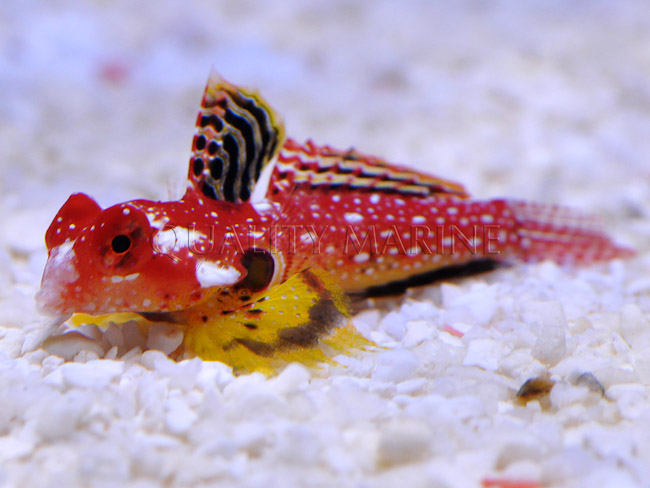A stunning ruby red dragonet of the genus Synchiropus has made a big splash in aquariums around the world. Starting in South Africa, then on to Singapore, Japan and Los Angeles, the brilliant red dragonet has been spotted in shipments of red scooter blennies from a unique collection location in the Philippines.

The guesses as to which species of Synchiropus the Ruby Red dragonet belongs to have ranged from Synchiropus moyeri, to Synchiropus morrissoni to the recently described Synchiropus tudorjonesi. Morrisson and Moyer’s dragonets have been ruled out on a variety of meristic values and although the ruby red dragonet look a helluva lot like S. tudorjonesi, it is significantly different from the latter to be a different species, perhaps undescribed and unknown to science. We even dug up some pictures of the also unknown Synchiropus rubrovinctus but that species is also pretty distinctive, and not like the Ruby Red Dragonet currently under scrutiny.

So although we do not know what the Ruby Red Dragonet is, we do know that is is off-the-hook gorgeous. The brilliant ruby colored body is puntuated by few small distinct white spots, vivid yellow pelvic fins that are highly contrasted by a dark black spot on the gill cover. As an added bonus it appears that male Ruby Red Dragonets also have some noticeable dark diagonal striping in the dorsal fin as well as metallic blue spots on the face under the eyes.

This current batch of the Ruby Red Dragonet originates from a particularly deep location in the Phillipines but a very similar specimen was hauled up by John Hansen and Rufus Kimura on a recent expedition in the South Pacific. Although the new super red Synchiropus fish looks quite similar to the Synchiropus tudornjonesi, that species seems to retain a dark going on black flank well into adulthood, and a slightly different pattern of white spots.
So, we know very little about the Ruby Red Synchiropus, but we know that there’s more than a spattering of them being brought up from the Philippines. Hopefully the specific collecting site of the new dragonet is readily accessible so that more specimens can make it to aquariums, from which point we could see aquarium pairings lead to captive breeding.
This investigative story was made possible by the contributions from many different aquarists around the world and we would like to thank Yuri Vendevetter, Junkai Ong, John Hansen and Quality Marine for their help in piecing together a picture of this exciting new aquarium fish.






